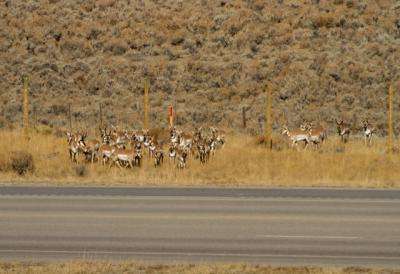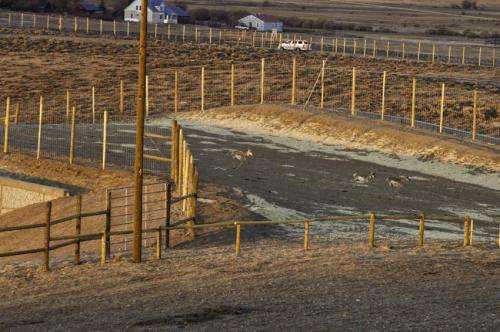Where the deer and the antelope cross

The locations of the structures completed this fall were informed by data collected by WCS, the Wyoming Cooperative Fish and Wildlife Research Unit, and the Wyoming Game and Fish Department, and identified the pronghorn's preferred migration routes and highway crossing points.
WCS has long studied an approximately 93-mile (150 km) migration of pronghorn between wintering grounds in the Upper Green River Basin and summering grounds in Grand Teton National Park (GTNP)—a migration corridor known as the "Path of the Pronghorn." WCS worked with many partners including Grand Teton National Park and Bridger-Teton National Forest to bring about the designation of the Path as the first and only federally designated migration corridor in the United States.
As part of their research, WCS scientists used GPS tracking collars to collect information over the course of five years on the location and timing of pronghorn movements and impediments to migration such as fences, roadways, pipelines, and other energy development infrastructure.

Using this information, the Wyoming Department of Transportation (WYDOT) was able to locate and build the structures as part of an effort to protect motorists and provide safe passage for migrating pronghorn and other wildlife in the Greater Yellowstone Ecosystem. Trapper's Point has historically been a "bottleneck" problem area for the pronghorn each year, causing thousands of the animals to cross traffic lanes on U.S. Highway 191, and creating a perilous situation for humans and wildlife alike.
WCS Associate Conservation Scientist Jon Beckmann said, "This truly was a collaborative effort that brought together many groups with many areas of expertise to accomplish a worthy goal that benefits both wildlife and people. Congratulations to WYDOT for committing the resources to this project and seeing it through successfully."
The overpass at Trapper's Point is one of eight safe passages constructed by WYDOT along a 13-mile stretch of highway. In addition, eight-foot high barrier fencing has been placed along the highway to channel the animals to the crossing points. In all, 2 overpasses and 6 underpasses have been constructed and will accommodate not only pronghorn, but also mule deer, moose , elk and other animals. The two overpass structures were specifically located and designed to address pronghorn migration conservation needs.
"The importance of these overpasses and their use by pronghorn cannot be overstated," said WCS Conservation Scientist Joel Berger. "They eliminate the danger of collisions and will help to preserve a spectacular element of our natural heritage—the longest mammal migration in the 48 contiguous United States. This is an accomplishment that all Americans can celebrate."
Provided by Wildlife Conservation Society

















